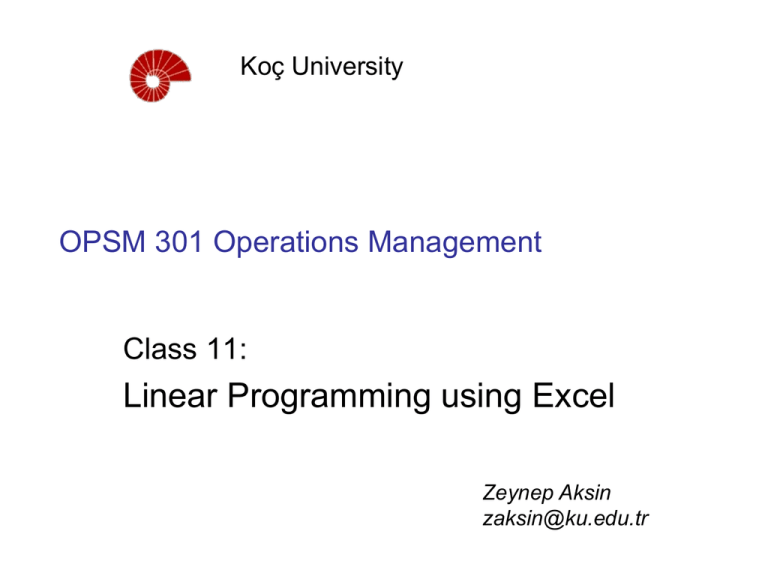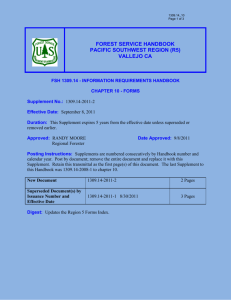OPSM 451 Service Operations Management
advertisement

Koç University OPSM 301 Operations Management Class 11: Linear Programming using Excel Zeynep Aksin zaksin@ku.edu.tr Announcement Linear programming: Appendix A from our book Skip graphical solution, skip sensitivity analysis for now You can use examples done in class, example A1, solved problem 1, Problem 3 as a study set (and all other problems if you like) Quiz 2 next Thursday Office hours by Tas as previously announced Linear Programming (LP) Making decisions on the allocation of scarce resources in environments of certainty using a mathematical optimization approach Example Applications OPSM: Product mix problem-how much of each product should be produced given resource constraints to maximize profits Finance: Construct a portfolio of securities that maximizes return while keeping "risk" below a predetermined level Marketing: Develop an advertising strategy to maximize exposure of potential customers while staying within a predetermined budget Conditions for Applicability of Linear Programming Resources must be limited There must be an objective function There must be linearity in the constraints and in the objective function Resources and products must be homogeneous Decision variables must be divisible and nonnegative Components of Linear Programming A specified objective or a single goal, such as the maximization of profit, minimization of machine idle time etc. Decision variables represent choices available to the decision maker in terms of amounts of either inputs or outputs Constraints are limitations which restrict the alternatives available to decision makers Components of Linear Programming There are three types of constraints: – (=<) An upper limit on the amount of some scarce resource – (>=) A lower bound that must be achieved in the final solution – (=) An exact specification of what a decision variable should be equal to in the final solution Parameters are fixed and given values which determine the relationships between the decision variables of the problem Example: Giapetto's Woodcarving Two types of toys are manufactured: soldiers and trains Soldiers: – Sells for $27 – Uses raw materials worth $10 – Each soldier increases variable labor and overhead costs by $14 Trains: – Sells for $21 – Uses raw materials worth $9 – Each train increases variable labor and overhead costs by $10 Giapetto's Woodcarving Manufacture requires skilled labor of two types – Carpentry – Finishing Resource requirements by product – Soldier: 1 hour of carpentry and 2 hours of finishing – Train: 1 hour of carpentry and 1 hour of finishing Total resources available – Unlimited raw materials – 80 hours of carpentry – 100 hours of finishing labor Giapetto's Woodcarving Demand – for trains is unlimited – At most 40 soldiers can be sold each week Objective is to maximize weekly profit Formulate as a linear program (LP) Towards the Mathematical Model: Define (decision variables) – x1 : number of soldiers produced each week – x2 : number of trains produced each week Objective function: – maximize weekly profit = weekly profit from soldiers + weekly profit from trains Constraints: – each week, no more than 100 hours of finishing time may be used – each week, no more than 80 hours of carpentry time may be used – each week, the number of soldiers produced should not exceed 40 because of limited demand Giapetto's Woodcarving: The LP Model max 3x1 + 2x2 subject to 2x1 + x2 100 x1 + x2 80 x1 40 x1 0 x2 0 Where (finishing hours) (carpentry hours) (demand for soldiers) (nonnegativity constraint) (nonnegativity constraint) – x1 : number of soldiers produced each week – x2 : number of trains produced each week The Excel Model soldiers changing cells profit soldiers finishing carpenter demand trains 20 3 trains 2 1 Total(obj ective) 60 2 180 used 1 1 capacity 100 80 20 100 80 40 Filled in by Excel Solver Reading the variable information The optimal solution for Giapetto is to produce 20 soldiers and 60 trains per week, resulting in an optimal profit of $180. (The maximum possible profit attainable is $180, which can be achieved by producing 20 soldiers and 60 trains) Example 1:Product Mix Problem P Q Sales price:90 $/unit Max demand:100 units/week D 10 min/un Purchase Part 5$/un C 10 min/un A 15 min/un. C 5 min/un B 15 min/un. D 5 min/un B 15 min/un A 10 min/un. Sales price: 100 $/unit Max Demand:50 units/week Products P and Q are produced using the given process routing. 4 machines are used:A,B,C,D. (available for 2400 min/week) The price and raw material costs are given. Problem: Formulate an LP to find the product mix that maximizes weekly profit. i.e. How many of each product should we produce given the capacity and demand constraints? What is the bottleneck of this process? RM1 20$/un RM2 20$/un RM3 20$/un 15 Source: Paul Jensen LP Formulation Decision variables: – P:Amount of product P to produce per week – Q:Amount of product Q to produce per week Objective Function: Maximize Profit – Max 45P+60 Q Constraints: Machine hours used should be less than or equal to 2400 minutes: – A: 15 P + 10 Q <= 2400 – B: 15 P + 30 Q <= 2400 – C: 15 P + 5 Q <= 2400 – D: 10 P + 5 Q <= 2400 Production should not exceed demand: – P<=100 – Q<=50 Non-negativity – – P>=0, Q>=0 16 Solver Solution P changing cells objective Coefficients Profit Constraint Coefficients: Machine A Machine B Machine C Machine D Demand P Demand Q Q 100 30 45 6300 60 P Q 15 15 15 10 1 0 L.H.S. Value 10 1800 <= 30 2400 <= 5 1650 <= 5 1150 <= 0 100 <= 1 30 <= R.H.S. 2400 2400 2400 2400 100 50 17 Example Problem The Huntz Company purchases cucumbers and makes two kinds of pickles: sweet and dill. The company policy is that at least 30%, but no more than 60%, of the pickles be sweet. The demand for pickles is SWEET:5000 jars + additional 3 jars for each $1 spent on advertising DILL:4000 jars + additional 5 jars for each $1 spent on advertising Sweet and dill pickles are advertised separately. The production costs are: SWEET:0.60 $/jar DILL:0.85 $/jar and the selling prices are: SWEET:1.45 $/jar DILL:1.75 $/jar Huntz has $16,000 to spend on producing and advertising pickles. Formulate an appropriate Linear Program. Solution: LP Formulation Xs: Number of Sweet pickle jars produced. Xd: Number of Dill pickle jars produced. As: Amount of advertisement done for Sweet Pickles in dollars Ad: Amount of advertisement done for Dill Pickles in dollars Objective; maximize profits: (Revenue - Cost) max[(1,45* Xs + 1,75* Xd)-( 0,6* Xs + 0,85* Xd + As + Ad)] Subject to: Demand Constraints: Xs ≤ 5,000 + 3As Xd ≤ 4,000 + 5Ad Budget Constraint: 0,6* Xs + 0,85* Xd + As + Ad ≤ 16,000 Ratio Constraint: Xs / (Xs + Xd) ≥ 0,3 0,7 Xs – 0,3 Xd ≥ 0 Xs / (Xs + Xd) ≤ 0,6 0,4 Xs – 0,6 Xd ≤ 0 Non-negativity Constraints: Xs, Xd, As, Ad ≥0









